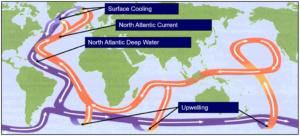In news- A recent study published in Nature Climate Change notes that this circulation, known officially as the Atlantic Meridional Overturning Circulation (AMOC), is losing its stability.
What does the study say?
Its findings support the assessment that the AMOC decline is not just a fluctuation or a linear response to increasing temperatures but likely means the approaching of a critical threshold beyond which the circulation system could collapse.
About Atlantic Meridional Overturning Circulation (AMOC)-
- The AMOC is a large system of ocean currents.
- It is the Atlantic branch of the ocean conveyor belt or Thermohaline circulation (THC), and distributes heat and nutrients throughout the world’s ocean basins.
- AMOC carries warm surface waters from the tropics towards the Northern Hemisphere, where it cools and sinks.
- It then returns to the tropics and then to the South Atlantic as a bottom current.
- From there it is distributed to all ocean basins via the Antarctic circumpolar current.

Impact of AMOC’s collapse-
- Without a proper AMOC and Gulf Stream, Europe will be very cold.
- Gulf Stream, a part of the AMOC, is a warm current responsible for mild climate at the Eastern coast of North America as well as Europe.
- AMOC shutdown would cool the northern hemisphere and decrease rainfall over Europe.
- It can also have an effect on the El Nino.
- AMOC collapse brings a prominent cooling over the northern North Atlantic and neighbouring areas.
- Sea ice increases over the Greenland-Iceland-Norwegian seas and to the south of Greenland, and a significant southward rain-belt migration over the tropical Atlantic.
- Freshwater from melting Greenland ice sheets and the Arctic region can make circulation weaker as it is not as dense as saltwater and doesn’t sink to the bottom.
Another study in February had revealed that AMOC had been relatively stable until the late 19th century. With the end of the little ice age in about 1850, the ocean currents began to decline, with a second, more drastic decline following since the mid-20th century
Reasons for the slowdown of AMOC-
- Climate models have long predicted that global warming can cause a weakening of the major ocean systems of the world.
- In July 2021, researchers noted that a part of the Arctic’s ice called “Last Ice Area” has also melted.
- The freshwater from the melting ice reduces the salinity and density of the water. Now, the water is unable to sink as it used to and weakens the AMOC flow.
- A 2019 study suggested that the Indian Ocean may also be helping the slowing down of AMOC as the Indian Ocean warms faster and faster, generating additional precipitation.
- With so much precipitation in the Indian Ocean, there will be less precipitation in the Atlantic Ocean, leading to higher salinity in the waters of the tropical portion of the Atlantic.
- This saltier water in the Atlantic, as it comes north via AMOC, will get cold much quicker than usual and sink faster.














